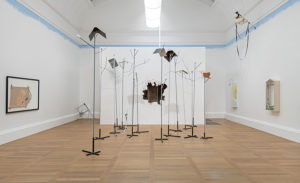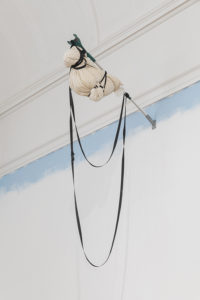“Empires and power structures disallow contradiction and plurality where they can find it,” writes Jesse Darling via email. The Berlin-based artist’s The Ballad of Saint Jerome solo exhibition is a coming-together of a set of coordinates they have been working on for some time. Running at London’s Tate Britain from September 22 to February 24, it’s viewed through the prism of the Christian myth of Saint Jerome’s taming of a ferocious lion. It runs that the wild animal appeared in the fourth century priest’s study. In recognising that the lion is not angry, but rather wounded. Jerome carefully removed a thorn stuck in the creature’s paw, after which the two remain lifelong companions.

The layout of The Ballad of Saint Jerome sits somewhere between that of a church and a museum. Some artworks are housed in distorted, reliquary-like boxes that question the relationship between art and religion. These and other pieces include an array of ladders, hooks and harnesses; concrete files, hands and metal etchings, as well as figurations of the lion. Themes of otherness, queerness, care and disability have been focused on Darling’s ephemeral sculpture and contorted image-making practice and the show at Tate Britain is no different.
A supplementary pamphlet printed with a correspondence between Darling and trans Christian activist Reverend Dr Christina Beardsley provides a further intellectual frame traversing myths, genderqueerness in the Church, and theology. The following continues in that vein:
Ephemera and myth
The distribution of ephemera starts with plaster lions flanking the entrance, sphinx-like with medical tubes attached and continuing through the hall with concrete-packed lever-arch files. Ladders are held aloft, the frames empty, museum cabinets twisted and images etched into metal. They contribute to an environment of wandering, like meaning is distributed in their interstices, in the assemblage of waste material and bric-a-brac. One could go as far as to say there is an implication that the queer, disabled, neurodivergent is operating in this flâneur-like mode, impendent to the manner of a bricoleur — working with what is at hand.

Grappling with art and identity, Darling wants their work to be understood as “intervening in the realm of ideas” in ways that may “[..]trouble the sovereign position.” For them, this is the generosity of vision that can participate in an “unsovereign” form of social thought.
Radical participatory modes are increasingly being rethought in relation to network culture. However, the lion-as-contagion operates in a much older form of virtual circulation travelling from the apex of Africa and Asia towards Northern Europe. Darling describes it “as a bad meme that travelled as a story in stone[…] And yet, the lion exists as a real creature, even a subject — perhaps also very literally a colonised subject — in a distant exotic elsewhere.” So in the fantasy of the lion the other is captured, and the wounded wild-ness tamed through an act of care and companionship. The double-bind of the myth is held for view somewhere between sovereign capture and genuine hapticality—between violence and care—like a general fissure point for contemporary conceptions of non-normativity.
The anticolonial as impossible
In much of the press and critical attention responding to The Ballad of Saint Jerome, there is a general absence of any sustained engagement with race or colonialism in relation to the artwork. Darling themselves writes in a short Tate primer, “Jerome, for me, becomes a stand-in for all those who claim knowledge and exercise sovereignty: the patriarch, the imperialist, the supremacist, the taxonomist and the practitioner of the medical/psychiatric/diagnostic industrial complex.”

In that line of thinking we can see the artist’s recontextualisation of cultural myth as a re-reading of dominant histories that constitute modernity, as well as hesitantly operating within a space of anti-/post-colonialism. Much of the artworks resignify the lion as an active social subject, while questioning the regimes of institutional power that subjugated their subjecthood. We see this, for instance, with the lion heads seemingly muzzled BDSM-like and cared-for by hospital-like tubing in a gesture that may make the other visible within the central dominant narrative of colonial modernity. Darling explicates, “certainly I see my gestures as an attempt at anti-colonial thinking, but from the impossible place inside the world-making system (white european christianity) that formed the coloniser — by which I also mean myself and [most of] my family.”
This work, these gestures, are impossible. Impossible through that erasure enacted in sovereign violence, in the violence of classification and othering. And yet, through a grounded reading of Western Christian myth, the possibility of doing deconstructive work without self-indulgent occidentalism is made that little bit clearer.
As Darling says, they are trying to: “look clearly at that ‘impossible’ — or just unacknowledged, disallowed, erased, unlanguaged? — place because it seems to me that this coloniality exists in an unquestioned faith in the high church of modernity and all that attends it. So in other words I don’t believe that petulant gestures of white guilt or shame or whatever even begin to address the ‘problem’, which is the question of how one becomes a coloniser in the first place — what kind of theologies, while preaching neighbourliness and brotherhood and so on — allowed for this kind of violent disidentification with an/other, and how might [we] — or, if you prefer, one — continue the work of this church while considering oneself secular, enlightened, ‘good’? All seems bound together.”

Darling’s questioning of the validity of an anti-colonial artwork in the Tate Britain as “empires and power structures disallow contradiction and plurality where they can find it” and thus forming complicity and participation in institutional subjectification, holds true, of course. However, the idea of the exhibits labouring through a specific fragmented instance of sovereign, colonial thinking elicits this subterranean, subaltern multitude of meaning in response — queer, neurodivergent, anticolonial, and so on. One is reminded of Gayatri Chakravorty Spivak’s provocation of the teacherliness of aesthetic work for the ‘noncoercive rearrangement of desire’. The Ballad of Saint Jerome trains the imagination through a dialectic of power and woundedness.
But the woundedness isn’t mimetic, it doesn’t directly symbolise something. There’s an unfolding at play: “And in general I don’t make claims that the work performs a politics, nor suffer others to do so if I can help it. It’s only art. But what art is good for — I think — is trying to work out the things for which words won’t [yet] do, or maybe for speaking the contradictions. There isn’t an argument to uphold; there isn’t a point to prove. The whole thing can be — as things are, as history tends to be — complicated, both one thing and another simultaneously.”
The contradiction — the non-argument — is of course the problem of the individual, making the problem of art the problem of the social. Modernity’s formation of the individual-subject precipitates a kind of un-sovereign position, a position without a place, a neighbourliness contorted and distorted and merely gestured to, much like the proliferous sculptures leaning and hanging in the exhibition hall, like discarded furniture and construction material.

The Lion as Icon
Ending with a return to the positionless icon, the lion, we may eke out a larger vision. The lion as icon exists, it has a social life, it draws the viewer into a world sensitive and sensual. It provides a trace of something altogether more alive in the Western tradition telling subterranean stories, and refusing white guilt while being attentive to colonial history. To work with the icon in relation to a socio-historical position of belowness — queer, disabled, neurodivergent — paints the spiritual in a very different light. Darling expands, “we are entering some kind of Kali Yuga which will perhaps devolve into something full on like the reformation and that the empirical fictions of post enlightenment modernity are starting to crumble like the petroleum economy, which is to say, some are doubling down and others who have less to lose are turning to oracles and prayer.” Darling is giving us shards of myth, visions of contemporary contradiction, and gestures at the impossible place where only lions can go.**













